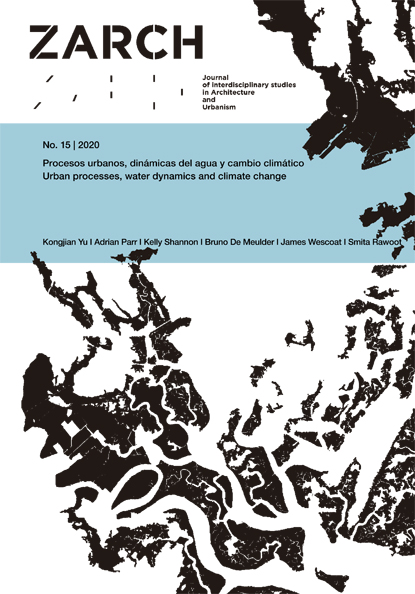Geometrías de límite en los filtros arquitectónicos. Racionalidad poética y emoción poética
DOI:
https://doi.org/10.26754/ojs_zarch/zarch.2020154648Palabras clave:
Armósferas Arquitectónicas, Filtros Arquitectónicos, Interferencia Visual, Fenómenos de Interferencia, LímiteResumen
Un filtro arquitectónico es una construcción material porosa que regula las relaciones transversales visuales y establece grados de conexión mediante la intervención de la luz y la visión. Las fronteras filtrantes exhiben proporciones variables de masa y aire que son fundamentales para la producción de la experiencia espacial tras la mediación de la materia y la geometría. El sistema estructural de un filtro sintetiza relaciones geométricas con la capacidad de generar atmósferas arquitectónicas, como resultado del borde activo que es técnicamente preciso y sensorialmente ambiguo de forma simultánea. El texto sostiene que las atmósferas que surgen tras el filtro no pueden tener lugar sin una producción geométrica precisa previa. La dimensión poética de las estrategias filtrantes se originan desde su capacidad de transformar la geometría concreta de sus condiciones de contorno y su ejecución material controlada en una atmósfera inesperada de propiedades emocionantes e inconmensurables.
Descargas
Citas
Allen, Stan. 1985. "Field Conditions," Points and Lines. Diagrams and Projects for the City. New York: Princeton Architectural Press.
Arnold, B. H. 1962. Intuitive Concepts in Elementary Topology. Englewood Cliffs, N.J.: Prentice-Hall.
Bertin, Jacques. 1967. Sémiologie Graphique. Les diagrames, les réseaux, les cartes (Semiology of Graphics: Diagrams, Networks, Maps) (with Marc Barbut et al). Paris: Gauthier-Villars.
Calvino, Italo. 1985. Six Memos for the Next Millennium. Milan: Eunaudi.
Chomsky, Noam; Piaget, Jean. 1980. Théories du language – Théories de l’apprentissage. (Theories of Language – Thearies of Learning). Paris: Du Seuil.
Díaz Moreno, Cristina; García Grinda, Efrén. 2004. "Ocean of Air," El Croquis 121/122. Madrid: El Croquis.
Gil Pita, Luis. 2001. "Desde el límite y la frontera," Circo 2001.90. Madrid: Circo.
Habraken, N. J. 2000. The Structure of the Ordinary. (Jonathan Teicher, ed.). Cambridge: MIT Press.
Heidegger, Martin. 1971. “Building, Dwelling, Thinking,” Poetry, Language, Thought. New York: Harper & Row.
Le Corbusier. 1953. The Modulor. London: Faber and Faber.
Le Ricolais, Robert. 1966. "Introduction to the Notion of Form," Data: Directions in Art, Theory and Aesthetics. Greenwich:
New York Graphic Society Ltd.
Le Ricolais, Robert. 1997. Visions and Paradox. Madrid: Fundación Cultural COAM.
Lévi-Strauss, Claude. 1962. La pensée sauvage. Paris: Plon.
Martí Arís, Carlos. 2008. "Tres paseos por las afueras," EAR 1. Barcelona: UPC.
Navarro Baldeweg, Juan. 1995. "El objeto es una sección. La geometría complementaria," Circo 1995.25. Madrid: Circo.
Neumeyer, Fritz. 1995. Mies van der Rohe. La palabra sin artificio. Reflexiones sobre arquitectura 1922/1968. Madrid: El Croquis.
Ortega y Gasset, José. 1957. Viajes y países. Madrid: Revista de Occidente.
Pallasmaa, Juhani. 1996. The Eyes of the Skin. Architecture and the Senses. New York: John Wiley & Sons.
Maria Rilke, Rainer. 1921. Mitsou. Histoire d'un chat. Paris: Rivage.
Sosa Díaz-Saavedra, José Antonio. 2006. "Condiciones de contorno," Arquitectura COAM, 345. Madrid: COAM.
Stanley Smith, Cyril. 1964. "Structure, Substructure, Superstructure," Structure in Art and Science. New York: George Braziller.
Wagensberg, Jorge. 2004. La Rebelión de las Formas. Barcelona: Tusquets.
Wittgenstein, Ludwig. 1921. Tractatus Logico-Philosophicus.
Zellini, Paolo. 1980. Breve storia dell'infinito. Milan: Adelphi.


